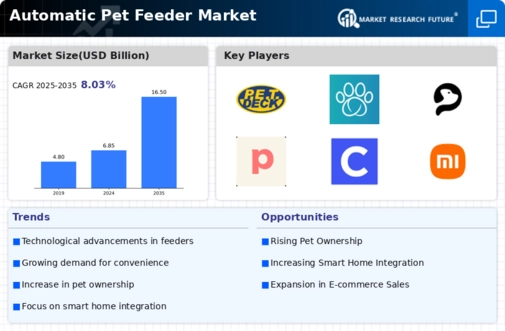E-commerce Growth
The rise of e-commerce platforms has transformed the retail landscape for the Global Automatic Pet Feeder Market Industry. Online shopping offers consumers convenience and access to a wider range of products, including automatic feeders. This shift in consumer behavior has been accelerated by the increasing reliance on digital platforms for purchasing pet supplies. As more consumers opt for online shopping, the market is expected to benefit from enhanced visibility and accessibility. The projected compound annual growth rate of 8.33% from 2025 to 2035 underscores the potential for e-commerce to drive sales in the automatic pet feeder segment.
Rising Pet Ownership
The Global Automatic Pet Feeder Market Industry experiences a notable surge in demand, driven by the increasing trend of pet ownership worldwide. As more households adopt pets, the need for convenient feeding solutions becomes paramount. In 2024, the market is projected to reach 6.85 USD Billion, reflecting the growing consumer preference for automated feeding systems. This trend is particularly evident in urban areas where busy lifestyles necessitate efficient pet care solutions. The convenience offered by automatic feeders aligns with the needs of pet owners, suggesting a sustained growth trajectory for the industry.
Sustainability Trends
Sustainability trends are becoming increasingly relevant within the Global Automatic Pet Feeder Market Industry. Consumers are more inclined to choose products that are environmentally friendly and ethically sourced. This shift is prompting manufacturers to develop feeders made from sustainable materials and to implement eco-friendly practices in production. As awareness of environmental issues grows, the demand for sustainable pet products is likely to rise. Companies that prioritize sustainability may gain a competitive edge, appealing to a conscientious consumer base that values eco-friendly options in their pet care choices.
Market Growth Projections
The Global Automatic Pet Feeder Market Industry is poised for substantial growth, with projections indicating a rise from 6.85 USD Billion in 2024 to 16.5 USD Billion by 2035. This growth trajectory suggests a compound annual growth rate of 8.33% from 2025 to 2035, reflecting increasing consumer adoption of automatic feeding solutions. The market's expansion is likely driven by various factors, including technological advancements, rising pet ownership, and heightened awareness of pet health. As the industry evolves, it may witness innovations that further enhance product offerings, catering to the diverse needs of pet owners.
Technological Advancements
Technological innovations play a crucial role in shaping the Global Automatic Pet Feeder Market Industry. The integration of smart technology, such as app connectivity and programmable feeding schedules, enhances user experience and pet care. These advancements not only provide convenience but also allow pet owners to monitor their pets' eating habits remotely. As consumers increasingly seek high-tech solutions, the market is likely to expand further. The anticipated growth from 6.85 USD Billion in 2024 to 16.5 USD Billion by 2035 indicates a robust demand for technologically advanced feeders, driven by consumer preferences for smart home integration.
Health and Nutrition Awareness
Growing awareness regarding pet health and nutrition significantly influences the Global Automatic Pet Feeder Market Industry. Pet owners are increasingly concerned about providing balanced diets and managing portion control for their pets. Automatic feeders facilitate precise feeding, helping to prevent obesity and other health issues. This trend is further supported by the rising availability of specialized pet foods that cater to specific dietary needs. As the market evolves, the demand for feeders that can dispense various food types and manage portion sizes is likely to increase, contributing to the overall growth of the industry.








